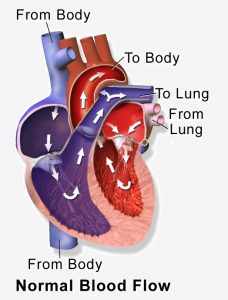The circulatory system is a network of blood vessels. Its main organ is the heart, pumping blood around the body. Running through these vessels are red blood cells, which transport oxygen to other organs. The blood also transports nutrients and hormones throughout the body.
The blood is pumped from the heart to the lungs, where it receives oxygen, as illustrated in the below image.
Top 20 Fun Facts
- Red blood cells lack a cell nuclei, which allows the cells to carry more oxygen through the body.
- Some animal species, such as mollusks and lobsters, have blue blood rather than red.
- Humans and most animals have varying shades of red blood cells. Darker cells lack oxygen and are heading to the heart and lungs to pick up more oxygen.
- There are no blood vessels in the cornea. Blood vessels would obstruct your vision, so instead nourishment for the corneal cells comes from the tears.
- The blood-brain barrier is a system of blood vessels that keep harmful microbes from reaching the brain while allowing certain molecules through, such as water.
- The weather outside of the body controls the size of blood vessels. In warmer weather, the vessels expand to release heat, while they constrict in colder weather to retain heat.
- Eating small amounts of dark chocolate can be beneficial to your overall cardiovascular health because it contains flavonoids that have antioxidants.
- Laughter really is the best medicine. It triggers endorphins to be released in the body, reduces stress, and increases blood circulation.
- While there are several types of muscle tissue, including skeletal, smooth, and cardiac muscles, the blood vessels only contain smooth muscle, located within the inner walls of the vessels.
- Red blood cells are highly flexible and small—roughly 8 microns in diameter. They fit through capillaries in single file to carry oxygen to body tissues.
- Larger animals tend to have a slower heart rate than smaller animals. For example, smaller dogs, such as Yorkshire terriers, have a faster heart rate than Great Danes.
- Women tend to have faster heart rates than men. This is likely related to the fact that they are usually smaller than men.
- Your heart can beat for several minutes outside of the body, until it runs out of energy. This is because it produces its own electrical signals.
- During the average lifetime, the human heart will beat 2.5 billion times. It will average 70 to 80 beats per minute.
- At rest, it takes approximately 6 seconds for blood to be pumped from the heart to the lungs and back again.
- The thumping sounds associated with heart beats are caused by valves between the chambers of the heart closing.
- A single droplet of blood contains around 5 million red blood cells.
- If you stretched out all of the body’s blood vessels end-to-end, including arteries, capillaries, and veins, they would extend over 60,000 miles.
- Red blood cells live for approximately 120 days. They are constantly being replaced by the bone marrow.
- Ancient Egyptians believed that the heart was the center of the body, rather than the brain. The heart was preserved carefully after death, while the brain was discarded.

